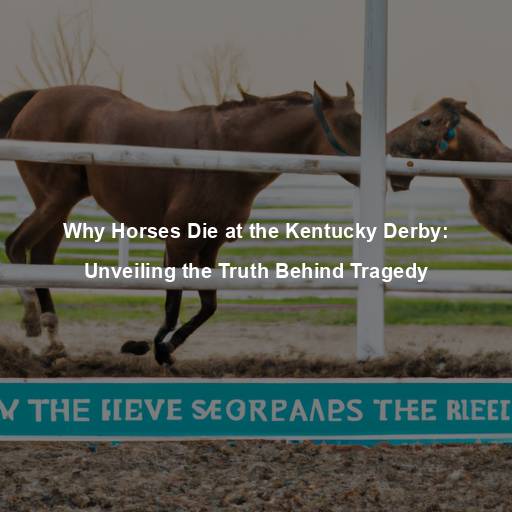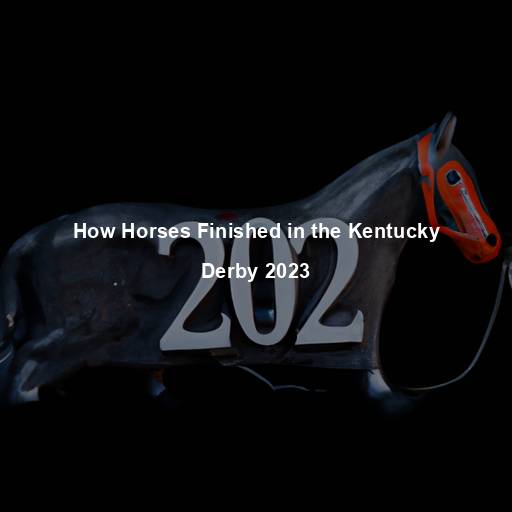Why Horses Die at the Kentucky Derby: Unveiling the Truth Behind Tragedy
Last Updated on October 26, 2023 by Evan
Contents
- 1 The History and Prestige of the Kentucky Derby
- 2 The Tragic Side of Horse Racing
- 3 The Industry’s Response: Striving for Safer Races
- 4 The Ongoing Debate: Balancing Tradition and Reform
- 5 The Impact of Technology on Horse Safety
- 6 The Importance of Public Awareness and Advocacy
- 7 A Shared Responsibility: The Future of Horse Racing Safety
- 8 FAQs: Why Horses Die in the Kentucky Derby
- 8.1 What are some reasons why horses die in the Kentucky Derby?
- 8.2 Are there any specific injuries that commonly occur in the Kentucky Derby?
- 8.3 Are the horses receiving proper veterinary care before and during the race?
- 8.4 Are the jockeys responsible for horse fatalities in the Kentucky Derby?
- 8.5 How does the Kentucky Derby organization address horse safety?
The History and Prestige of the Kentucky Derby
For more than a century, the illustrious Kentucky Derby has enthralled and beguiled spectators as it gracefully gallops into the hearts of racing enthusiasts. Known fondly as the “Run for the Roses,” this prestigious event takes place on the first Saturday of May, transforming Churchill Downs into a captivating stage of equine excellence. As the opening act of the revered Triple Crown, which includes the esteemed Preakness Stakes and storied Belmont Stakes, the Kentucky Derby weaves an intricate tapestry that melds the grandeur of sport with a fervent homage to America’s equestrian heritage. Join us in experiencing this mesmerizing blend of legacy, tradition, and extraordinary athleticism.
The Tragic Side of Horse Racing
While the Kentucky Derby is a spectacle of speed, grace, and elegance, it is not without its darker side. Behind the glamour and excitement lies a haunting reality – the risks and dangers that horses face on the racetrack. Each year, as the world watches the Derby with bated breath, there is always the underlying fear that tragedy may strike.
The Perils of Horse Racing
- Physical Demands and Injuries: Thoroughbred racehorses are subjected to intense physical demands, pushing their bodies to the limits of their endurance. The high-speed gallops, sharp turns, and the sheer competitive nature of the race can take a toll on their fragile legs and joints, leading to injuries such as fractures, sprains, and strains.
Experiencing the enigmatic and perplexing condition referred to as “tying-up,” exertional rhabdomyolysis manifests when a horse’s muscles undergo rapid deterioration due to intense physical strain. The consequence of this bewildering phenomenon can encompass excruciating agony, potential kidney impairment, and in grave situations, the unfathomable demise of the equine if expeditious medical intervention is not sought.
In the heat of the Kentucky Derby, when the racehorse’s thundering hooves create a symphony of anticipation, there lies a hidden turmoil within. The hearts and lungs of these magnificent creatures are bound on a treacherous journey, their every beat a testament to the relentless pursuit of victory. As they gallop towards the finish line, their cardiovascular system battles against the surging tides of stress, amplifying the precariousness of their existence. It is amidst this tempest that the shadow of heart attacks and other cardiac-related tribulations looms, casting a veil of uncertainty over the high-stakes race.
- Heat and Humidity: The Kentucky Derby is held in May, which means horses must contend with the potential challenges of hot and humid weather. High temperatures combined with the physical exertion of the race can lead to heatstroke and dehydration, further endangering the horses’ well-being.
The Most Notable Tragedies in Kentucky Derby History
While horse racing is undoubtedly thrilling, it has witnessed several heartbreaking tragedies throughout its existence. These incidents serve as stark reminders of the inherent risks associated with the sport.
The year was 2006, when the Kentucky Derby witnessed a heartbreaking event that left the world both bewildered and sorrowful. Barbaro, a magnificent racehorse, achieved a remarkable triumph in the Derby, only to face an unthinkable fate in the Preakness Stakes. In an instant, Barbaro’s right hind leg shattered, sending shockwaves of disbelief throughout the racing community. Although a team of experts employed groundbreaking surgical techniques in a valiant effort to save him, Barbaro’s brave battle ultimately ended in heartbreak.
- Eight Belles (2008): Another devastating moment occurred when Eight Belles finished second in the 2008 Kentucky Derby and tragically collapsed shortly after crossing the finish line. It was later revealed that she suffered compound fractures in both front ankles, leading to her euthanasia on the track.
In the world of horse racing, there are tales that are etched in our hearts and minds forever. Among them is the gripping narrative of Ruffian, a phenomenal filly whose untimely demise left an indelible mark on the sport. In a fateful match against Foolish Pleasure, Ruffian, with her unblemished record, confronted a cruel twist of fate when she tragically suffered a devastating leg injury. The valiant efforts of a team of experts who performed emergency surgery couldn’t stave off the imminent tragedy that unfolded before their eyes, leaving us all grappling with the intrinsic uncertainties of this exhilarating but perplexing world.
The Industry’s Response: Striving for Safer Races
In the wake of these heartbreaking incidents, the horse racing industry has taken steps to address the safety concerns surrounding the sport. While accidents can never be completely eliminated, significant efforts have been made to minimize the risks and protect the well-being of the horses.
Advancements in Track Surfaces and Vetting Procedures
When it comes to the world of horse racing, there’s a thrilling shift happening behind the scenes. In a bid to enhance the safety and performance of these magnificent animals, racing surfaces are undergoing a fascinating transformation. The conventional dirt tracks are now giving way to innovative synthetic surfaces like Polytrack or Tapeta, which bring a refreshing wave of change. With improved shock absorption and a decreased risk of injuries, these surfaces carry the potential to revolutionize the sport, ensuring a more stable and adaptable experience regardless of the weather conditions.
In a relentless pursuit of equine welfare, race organizers have introduced more rigorous vetting procedures in an effort to safeguard the health and safety of our four-legged athletes. A meticulous evaluation process now takes place prior to each race, leaving no stone unturned in the quest to identify any lurking health issues or lingering injuries that could hamper a horse’s performance. These indispensable measures are specifically designed to bar horses with underlying conditions from entering the competition, thereby significantly reducing the chances of unfortunate mishaps on the track. Cheers to a more secure and protected world of horse racing!
Veterinary Care and Rehabilitation Programs
- Enhanced Veterinary Care: The well-being of racehorses is now a top priority, with enhanced veterinary care available at racetracks. On-site veterinary teams provide immediate attention to injured horses, offering potential life-saving interventions. Continuous monitoring and follow-up care help manage any long-term effects and aid in the recovery process.
In the realm of equine wellness, a realm filled with equal parts hope and bewilderment, lies the enigmatic world of rehabilitation programs. These ethereal establishments have emerged as beacons of solace for those magnificent creatures of the hoof who find themselves ensnared in the clutches of injury. Through a harmonious symphony of rest, rehabilitation exercises, and targeted therapies, these programs strive to orchestrate a triumphant return to equine glory, where once fractured bodies regain their vigor and nimbleness. With unyielding dedication and boundless compassion, these programs become the guardians of hope, offering horses the opportunity to savor the sweet taste of a vibrant existence beyond the confines of the racetrack.
Research and Education Initiatives
- Industry Collaboration: Horse racing organizations have joined forces with veterinary experts and researchers to study the causes of injuries and explore innovative solutions. Collaboration between industry stakeholders and academia has led to a better understanding of the biomechanics of racing, identifying potential risk factors, and implementing preventive measures.
Education and training hold paramount importance in the realm of horse racing, particularly when it comes to safeguarding the well-being and security of these majestic creatures. As the industry constantly evolves, comprehensive programs and initiatives have emerged to equip trainers, jockeys, and individuals involved with the necessary knowledge and skills. These endeavors focus on inculcating best practices, injury prevention techniques, and instilling a deep sense of responsible horsemanship within all stakeholders, thus fostering a culture of awareness and accountability.
The Ongoing Debate: Balancing Tradition and Reform
The realm of horse racing has witnessed commendable efforts towards enhancing safety measures, yet it relentlessly grapples with ongoing scrutiny and a lingering state of debate. Those critical of the sport ardently contend that transformative reforms are imperative to ensuring the welfare of these majestic creatures, while a contrasting faction remains steadfast in their belief that preserving traditional racing customs takes precedence. The perplexing and layered nature of this discussion continues to captivate and challenge the industry.
Calls for Stricter Regulations and Oversight
-
Medication Reform: One area of concern is the use of medications in horse racing. Critics argue that the widespread use of drugs, such as Lasix, may mask underlying health issues, potentially increasing the risk of catastrophic injuries. Calls for stricter regulations regarding medication use and testing have gained traction within the industry.
-
Breeding Practices: Some argue that breeding practices contribute to the fragility of racehorses. The emphasis on speed and conformation in breeding programs may lead to horses with weaker bone structures and a higher susceptibility to injuries. Encouraging breeding practices that prioritize soundness and durability could help mitigate these risks.
Preserving Tradition and Cultural Significance
The storied past of horse racing is intertwined with the fabric of many societies, bearing witness to its historical and cultural resonance. Upholding the cherished traditions that define this sport is paramount, according to its supporters. While ensuring the safety of both horses and jockeys is of utmost importance, they assert that measured reforms can be implemented to achieve this goal, without diluting the very essence that makes horse racing so special.
- Economic Impact: Horse racing contributes significantly to local economies, generating revenue and supporting numerous jobs. Supporters argue that the sport’s economic impact should be considered when discussing reforms, as drastic changes could have unintended consequences for the industry and the communities it sustains.
Jockeys: Skilled Athletes Guiding Equine Excellence
Jockeys play a vital role in horse racing, acting as the pilots who guide these magnificent animals to victory. Their expertise in race strategy, horsemanship, and communication with the horses is crucial for a safe and successful race. Jockeys undergo rigorous training to develop the necessary skills and knowledge to handle the physical and mental demands of horse racing.
- Weight Management: Jockeys must maintain a specific weight to ensure the horse’s optimal performance. Strict weight regulations are in place to prevent excessive burden on the horses and reduce the risk of injuries. Jockeys often follow strict diets and exercise regimens to maintain their weight within the required limits.
When it comes to the fast-paced world of horse racing, the art of communication is key. Jockeys and their equine partners must engage in a delicate dance, relying on instinct and intuition to navigate the track. Expertly decoding the subtle messages conveyed through body language and responding with lightning-fast reflexes, jockeys possess the power to avert disaster and ensure the safety of both horse and rider. The intricate interplay between human and horse creates a mesmerizing spectacle that captivates both the avid racing enthusiast and the casual observer alike.
Trainers: Guardians of Equine Health and Fitness
The world of horse racing is an intricate web of passion, responsibility, and expertise. Within this realm, trainers emerge as the unsung heroes, dedicating themselves to the intricate care and conditioning of these magnificent racehorses. As they orchestrate the daily routines, training sessions, and overall management, trainers find themselves engrossed in a swirling vortex of uncertainty and intensity. With their watchful eyes and knowledgeable minds, they act as the guardians of these equine athletes, collaborating with veterinarians and experts to craft a holistic approach to their well-being.
- Training Programs: Trainers design individualized training programs tailored to each horse’s specific needs and capabilities. These programs focus on building strength, stamina, and agility while minimizing the risk of injuries. Regular exercise, proper nutrition, and rest are integral to the training regimen.
Keeping a close eye on the horses’ well-being is of paramount importance in the world of racing. Trainers work diligently to detect any signs of unease, illness, or injuries that could arise. Through regular check-ups with veterinarians, diagnostic exams, and preventive measures like vaccines and deworming, trainers carry out a holistic approach to maintaining the horses’ health. By proactively addressing any potential health concerns, trainers not only mitigate risks but also ensure that the horses are in top form for their racing endeavors.
The Impact of Technology on Horse Safety
Technology has radically transformed the landscape of horse racing, revolutionizing its safety protocols in unprecedented ways. From cutting-edge equipment to groundbreaking medical therapies, advancements have forged a path toward safeguarding the well-being of horses and their jockeys. The evolution of track surfaces has also played a role, with state-of-the-art materials ensuring a smoother ride, minimizing risks and enhancing the overall security of the sport. Embracing these innovative developments has become a vital aspect of modern horse racing, promising a future that marries tradition with the wonder of technological progress.
Track Surfaces: A Foundation of Safety
When it comes to the safety of our equine athletes and the brave jockeys who ride them, the racing surface takes center stage. Over the years, track surfaces have undergone remarkable transformations, driven by a burning desire to offer superior shock absorption, enhanced grip, and unwavering stability. The evolution of these racing terrains has left both experts and enthusiasts in awe, as they witness the bewildering progress that aims to minimize injuries and maximize performance.
In the world of equestrian sports, an intriguing revolution has taken place with the advent of synthetic surfaces. These innovative track materials, including the renowned Polytrack and Tapeta, have captured the spotlight with their enigmatic ability to absorb shock. With their remarkable all-weather properties, these surfaces provide a perpetual mystery, ensuring an enduring and gentle impact on the majestic horses’ delicate joints and bones.
Ensuring the safety of racing surfaces demands a meticulous dance of maintenance and preparation. The meticulous tasks of watering, grading, and rolling of the track are essential steps to preserve optimal conditions. Through diligent monitoring of moisture levels and the skilled utilization of specialized equipment, the elusive goal of achieving the perfect track consistency is pursued. Unpredictable like the winds of change, this delicate process keeps the racing world on its toes.
Equipment and Safety Gear: Protecting Horses and Jockeys
Racing enthusiasts rejoice, for the world of horse racing is witnessing a remarkable evolution in the form of cutting-edge equipment and state-of-the-art safety gear. The realm of equine athleticism has been forever transformed, marked by a cascade of groundbreaking innovations that undoubtedly prioritize the well-being of both majestic horses and fearless jockeys. Prepare to be astounded as we delve into the bewildering world of equestrian advancements – a realm where tradition and modernity collide, leaving us in awe of the inventive marvels that safeguard those who gallop towards victory. Let us embark on this riveting journey, unveiling the enigmatic facets of these incredible developments that have forever reshaped the tapestry of the racing world.
Jockeys have taken a firm leap towards safeguarding their heads by embracing specialized helmets exclusively catered to the thrilling world of horse racing. These cutting-edge head protectors are meticulously crafted to withstand the impact of falls and collisions, ensuring the safety of these courageous riders. With this progressive approach, the jockeys have embraced a new level of assurance and security while adding an additional layer of intrigue to the already enigmatic sport.
Shielding Your Core: When it comes to the high-stakes world of horse racing, nothing is left to chance, especially when it comes to protecting the jockeys’ most precious assets. Enter body protectors, the silent heroes standing between life and injury on the track. With their innovative design, these robust yet lightweight flak jackets offer a comforting embrace, providing an extra layer of defense as jockeys navigate the turbulence of the racecourse. So breathe a sigh of relief knowing that their vital organs are shielded, allowing these intrepid riders to chase their dreams without hesitation.
- Horse Boots: Specialized boots and bandages are used to protect horses’ legs during races. These boots offer support, reduce the risk of impact injuries, and provide added stability.
Veterinary Advancements: Ensuring Equine Well-being
The field of equine veterinary medicine has seen significant advancements, enabling more accurate diagnoses, improved treatments, and better overall care for racehorses. Veterinary professionals play a critical role in safeguarding the health and well-being of these magnificent animals.
- Diagnostic Imaging: Technologies such as X-rays, ultrasound, and MRI have revolutionized the diagnosis of equine injuries. These imaging techniques allow veterinarians to identify subtle fractures, soft tissue damage, and other underlying conditions that may affect a horse’s racing career.
Discover the groundbreaking realm of regenerative therapies, where the hopes of healing and recovery intertwine with cutting-edge medical innovations. Embark on a journey that explores the transformative potential of treatments like stem cell therapy and platelet-rich plasma (PRP), unveiling an array of possibilities for the rejuvenation of racehorses. Witness firsthand how these regenerative therapies foster tissue repair and regeneration, crafting a path towards the rehabilitation and revitalization of these majestic creatures.
- Pain Management: Improved understanding of equine pain management has led to the development of more effective and targeted pain relief strategies. Veterinarians now have a range of medications and treatment options to alleviate pain and discomfort in racehorses, ensuring their well-being both during and after races.
The Importance of Public Awareness and Advocacy
In today’s ever-changing landscape, shedding light on the world of horse racing and its inherent complexities is essential to cultivate an environment that prioritizes safety and responsibility. Progressive advocacy groups, diligent regulatory bodies, and forward-thinking racing organizations synergistically contribute to propelling the ideals of transparency, education, and ethical conduct forward. With each stakeholder playing a distinct role, the intricate tapestry of this industry gradually unravels, leaving us both intrigued and perplexed.
Public Engagement and Education
It is of paramount importance to actively involve the public in the captivating world of horse racing, with the ultimate goal of eradicating any distorted perceptions and fostering a genuine appreciation for safety measures. Through an array of dynamic initiatives such as thought-provoking discussions, enlightening educational campaigns, and interactive outreach programs, we can successfully shed light on the remarkable endeavors directed towards the welfare of these majestic creatures. By instigating open conversations and inviting people to delve into the intricacies of this awe-inspiring sport, the misconception-laden barriers will crumble and pave the way for unwavering support.
Industry Regulations and Oversight
It’s no secret that the horse racing industry heavily relies on regulatory bodies to maintain order, ensure safety, and keep a keen eye on compliance. With the ever-evolving landscape of this beloved sport, raised eyebrows and bemused minds wonder: how can we strike a balance between passion and protection? As we tread through uncharted territories, embracing the power of stricter regulations on medication use, track conditions, and breeding practices, we embark on a perplexing journey, aiming to safeguard the noble creatures that captivate our hearts and stir our emotions on the racetrack.
Research and Collaboration
In a world where equine safety in the racing industry is of paramount importance, the key to progress lies in the convergence of minds. A harmonious symphony of scientists, veterinarians, industry stakeholders, and advocacy groups must join hands, pooling their vast resources and knowledge to forge a path to safer horseracing. Only through this collective effort, where data is freely shared, comprehensive studies are conducted, and innovative preventive measures are developed, can the industry truly navigate the murky waters of emerging risks and implement foolproof protocols rooted in irrefutable evidence.
The quest for ensuring the absolute safety and well-being of the majestic racehorses entrusted in the hands of the Kentucky Derby and the broader horse racing industry necessitates a synchronized symphony of collaborative actions. This harmonious dance involves an amalgamation of various players, from the seasoned industry maestros to the watchful guardians of regulations, the skilled jockeys pushing the boundaries, the diligent trainers shaping equine athletes, the nurturing veterinarians ensuring their physical and mental health, and not to forget, the ever-vigilant public whose hearts beat in unison for these magnificent creatures. Only through this intricate interplay of dedication, expertise, and unwavering passion can we weave a tapestry of safety, ushering in a new paradigm of protectorship for these graceful beings of gallop.
The Kentucky Derby holds a special place in our hearts, embodying the spirit of competition, excellence, and the timeless bond between humans and horses. As we celebrate the thrill and tradition of this iconic event, let us also remember the responsibility we bear in protecting the magnificent athletes that make it possible. Through ongoing research, collaboration, and a commitment to continuous improvement, we can ensure a safer future for the horses that capture our imaginations and inspire us with their remarkable performances.
FAQs: Why Horses Die in the Kentucky Derby
What are some reasons why horses die in the Kentucky Derby?
The Kentucky Derby, a display of supreme athleticism and equine prowess, is not without its shadowy secrets and untold tales. Behind the scenes of this thrilling spectacle lies a perplexing truth – the dark and enigmatic realm of horse fatalities. As the majestic beasts take their place on the hallowed grounds of Churchill Downs, their fate hangs in the balance, a delicate interplay of factors conspiring to unleash chaos and devastation. The electrifying speed, fierce competition, and sheer magnitude of the race cast an alluring charm, but beneath the surface lies a tempest of trepidation, where the very essence of these magnificent creatures is pushed to its limits. Amidst the deafening clamor of the crowd and the foreign surroundings, a maelstrom of stress and uncertainty ensues, weaving an intricate web that can snare both the noblest of hearts and the strongest of limbs.
Are there any specific injuries that commonly occur in the Kentucky Derby?
Yes, certain types of injuries are more prevalent in high-stakes races like the Kentucky Derby. One of the most devastating injuries is a fractured leg or limb. These fractures often occur due to the immense forces placed on the horse’s skeletal structure during intense racing. Other common injuries include tendon and ligament damage, which can result from the repetitive stress on the horse’s legs. Additionally, cardiovascular issues such as heart attacks or ruptured arteries can occur due to the extreme physical exertion.
Are the horses receiving proper veterinary care before and during the race?
The Kentucky Derby, known for its prestigious reputation, takes the welfare of its magnificent equine competitors seriously. With a series of robust regulations and guidelines, race organizers strive to ensure the race is as safe as possible. Every horse partaking in the event undergoes rigorous examinations conducted by experienced veterinarians, guaranteeing their fitness for the race. Despite the comprehensive measures taken, the dynamic nature of horse racing means that unforeseen circumstances or underlying health conditions can occasionally contribute to unfortunate incidents during this highly anticipated event.
Are the jockeys responsible for horse fatalities in the Kentucky Derby?
While jockeys play a significant role in guiding and controlling the horses during the race, they are not solely responsible for horse fatalities. Jockeys receive extensive training and are well-aware of the importance of horse safety. They strive to ride responsibly and avoid dangerous situations. Ultimately, the health and physical condition of the horse, as well as factors beyond the jockey’s control, can have a more significant impact on the horse’s fate.
How does the Kentucky Derby organization address horse safety?
The Kentucky Derby and the associated horse racing organizations take horse safety very seriously. They continually assess and improve safety measures to minimize the risk of injuries and fatalities. It includes evaluating track surfaces and conditions, implementing strict regulations regarding doping and medication usage, and investing in advanced veterinary technologies. The Kentucky Derby organization collaborates with experts to ensure the well-being of the horses and improve safety standards whenever possible.







